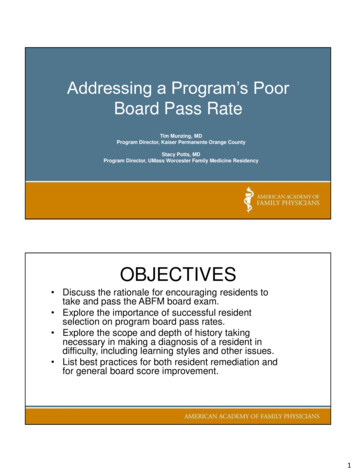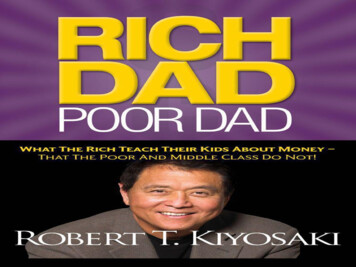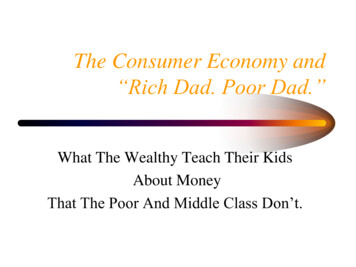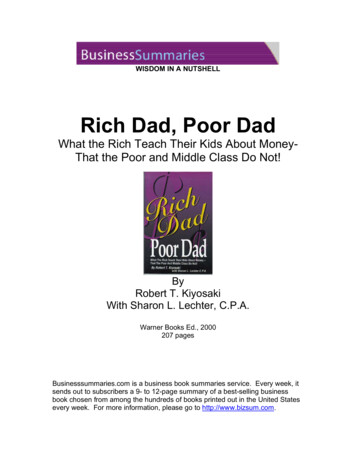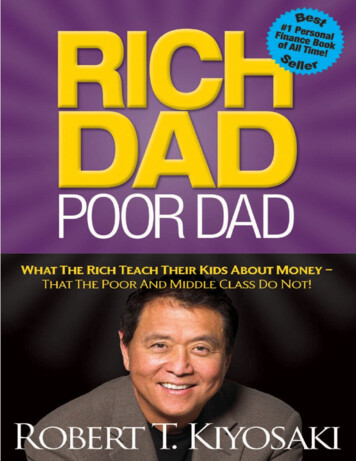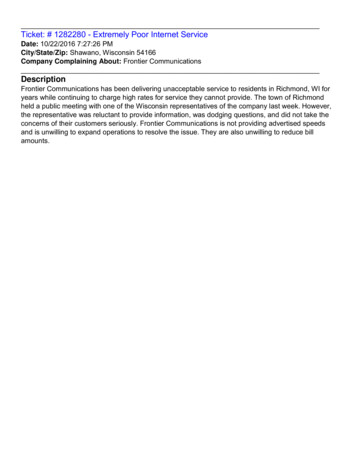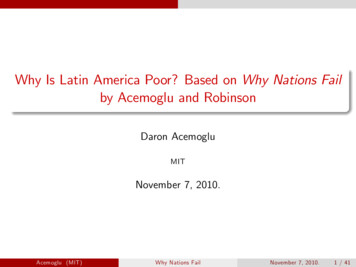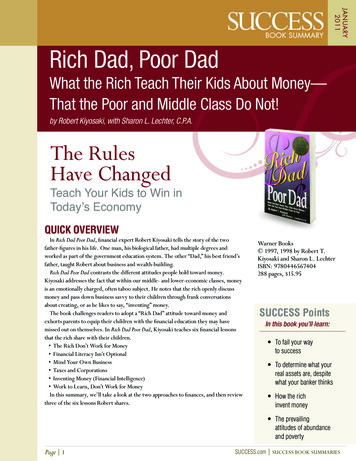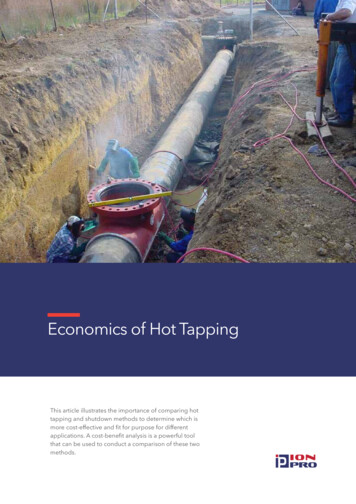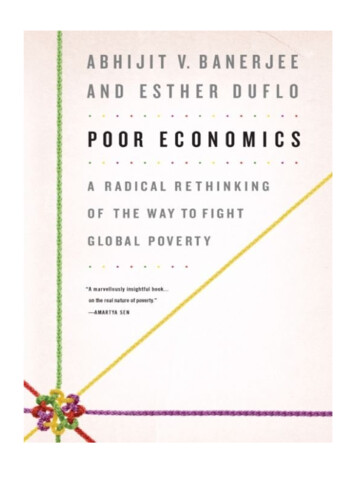
Transcription
Table of ContentsTitle PageDedicationForewordChapter 1 - Think Again, AgainTRAPPED IN POVERTY?PART I - Private LivesChapter 2 - A Billion Hungry People?ARE THERE REALLY A BILLION HUNGRYPEOPLE?ARE THE POOR REALLY EATING WELL,AND EATING ENOUGH?WHY DO THE POOR EAT SO LITTLE?SO IS THERE REALLY A NUTRITION-BASEDPOVERTY TRAP?Chapter 3 - Low-Hanging Fruit for Better (Global)Health?THE HEALTH TRAPWHY AREN’T THESE TECHNOLOGIES USEDMORE?
4/591UNDERSTANDING HEALTH-SEEKINGBEHAVIORTHE VIEW FROM OUR COUCHChapter 4 - Top of the ClassSUPPLY-DEMAND WARSTHE CURSE OF EXPECTATIONSWHY SCHOOLS FAILREENGINEERING EDUCATIONChapter 5 - Pak Sudarno’s Big FamilyWHAT IS WRONG WITH LARGE FAMILIES?DO THE POOR CONTROL THEIR FERTILITYDECISIONS?CHILDREN AS FINANCIAL INSTRUMENTSTHE FAMILYPART II - InstitutionsChapter 6 - Barefoot Hedge-Fund ManagersTHE HAZARDS OF BEING POORTHE HEDGEWHERE ARE THE INSURANCE COMPANIESFOR THE POOR?Chapter 7 - The Men from Kabul and the Eunuchsof India: The (Not So) Simple .LENDING TO THE POOR
5/591MICRO INSIGHTS FOR A MACRO PROGRAMDOES MICROCREDIT WORK?THE LIMITS OF MICROCREDITHOW CAN LARGER FIRMS BE FINANCED?Chapter 8 - Saving Brick by BrickWHY THE POOR DON’T SAVE MORETHE PSYCHOLOGY OF SAVINGSPOVERTY AND THE LOGIC OF SELFCONTROLChapter 9 - Reluctant EntrepreneursCAPITALISTS WITHOUT CAPITALTHE BUSINESSES OF THE POORGOOD JOBSChapter 10 - Policies, PoliticsPOLITICAL ECONOMYCHANGES AT THE MARGINDECENTRALIZATION AND DEMOCRACY INPRACTICEAGAINST POLITICAL ECONOMYIn Place of a Sweeping ConclusionAcknowledgementsNotesIndexCopyright Page
For our mothers,Nirmala Banerjee andViolaine Duflo
ForewordEsther was six when she read in a comic book onMother Teresa that the city then called Calcutta wasso crowded that each person had only 10 square feetto live in. She had a vision of a vast checkerboard ofa city, with 3 feet by 3 feet marked out on theground, each with a human pawn, as it were,huddled into it. She wondered what she could doabout it.When she finally visited Calcutta, she was twentyfour and a graduate student at MIT. Looking out ofthe taxi on her way to the city, she felt vaguely disappointed; everywhere she looked, there was emptyspace—trees, patches of grass, empty sidewalks.Where was all the misery so vividly depicted in thecomic book? Where had all the people gone?At six, Abhijit knew where the poor lived. Theylived in little ramshackle houses behind his home inCalcutta. Their children always seemed to have lotsof time to play, and they could beat him at anysport: When he went down to play marbles withthem, the marbles would always end up in the pockets of their ragged shorts. He was jealous.
8/591This urge to reduce the poor to a set of clichés hasbeen with us for as long as there has been poverty:The poor appear, in social theory as much as in literature, by turns lazy or enterprising, noble orthievish, angry or passive, helpless or self-sufficient.It is no surprise that the policy stances that correspond to these views of the poor also tend to be captured in simple formulas: “Free markets for thepoor,” “Make human rights substantial,” “Deal withconflict first,” “Give more money to the poorest,”“Foreign aid kills development,” and the like. Theseideas all have important elements of truth, but theyrarely have much space for average poor women ormen, with their hopes and doubts, limitations andaspirations, beliefs and confusion. If the poor appear at all, it is usually as the dramatis personae ofsome uplifting anecdote or tragic episode, to be admired or pitied, but not as a source of knowledge,not as people to be consulted about what they thinkor want or do.All too often, the economics of poverty gets mistaken for poor economics: Because the poor possessvery little, it is assumed that there is nothing interesting about their economic existence. Unfortunately, this misunderstanding severely underminesthe fight against global poverty: Simple problems
9/591beget simple solutions. The field of anti-povertypolicy is littered with the detritus of instant miraclesthat proved less than miraculous. To progress, wehave to abandon the habit of reducing the poor tocartoon characters and take the time to really understand their lives, in all their complexity and richness. For the past fifteen years, we have tried to dojust that.We are academics, and like most academics weformulate theories and stare at data. But the natureof the work we do has meant that we have also spentmonths, spread over many years, on the groundworking with NGO (nongovernmental organization)activists and government bureaucrats, health workers and microlenders. This has taken us to the backalleys and villages where the poor live, asking questions, looking for data. This book would not havebeen written but for the kindness of the people wemet there. We were always treated as guests eventhough, more often than not, we had just walked in.Our questions were answered with patience, evenwhen they made little sense; many stories wereshared with us.1Back in our offices, remembering these storiesand analyzing the data, we were both fascinated andconfused, struggling to fit what we were hearing and
10/591seeing into the simple models that (often Westernor Western-trained) professional development economists and policy makers have traditionally usedto think about the lives of the poor. More often thannot, the weight of the evidence forced us to reassessor even abandon the theories that we brought withus. But we tried not to do so before we understoodexactly why they were failing and how to adaptthem to better describe the world. This book comesout of that interchange; it represents our attempt toknit together a coherent story of how poor peoplelive their lives.Our focus is on the world’s poorest. The averagepoverty line in the fifty countries where most of thepoor live is 16 Indian rupees per person per day.2People who live on less than that are considered tobe poor by the government of their own countries.At the current exchange rate, 16 rupees correspondsto 36 U.S. cents. But because prices are lower inmost developing countries, if the poor actuallybought the things they do at U.S. prices, they wouldneed to spend more—99 cents. So to imagine thelives of the poor, you have to imagine having to livein Miami or Modesto with 99 cents per day for almost all your everyday needs (excluding housing). Itis not easy—in India, for example, the equivalent
11/591amount would buy you fifteen smallish bananas, orabout 3 pounds of low-quality rice. Can one live onthat? And yet, around the world, in 2005, 865 million people (13 percent of the world’s population)did.What is striking is that even people who are thatpoor are just like the rest of us in almost every way.We have the same desires and weaknesses; the poorare no less rational than anyone else—quite the contrary. Precisely because they have so little, we oftenfind them putting much careful thought into theirchoices: They have to be sophisticated economistsjust to survive. Yet our lives are as different as liquor and liquorice. And this has a lot to do with aspects of our own lives that we take for granted andhardly think about.Living on 99 cents a day means you have limitedaccess to information—newspapers, television, andbooks all cost money—and so you often just don’tknow certain facts that the rest of the world takes asgiven, like, for example, that vaccines can stop yourchild from getting measles. It means living in aworld whose institutions are not built for someonelike you. Most of the poor do not have a salary, letalone a retirement plan that deducts automaticallyfrom it. It means making decisions about things
12/591that come with a lot of small print when you cannoteven properly read the large print. What doessomeone who cannot read make of a health insurance product that doesn’t cover a lot of unpronounceable diseases? It means going to vote whenyour entire experience of the political system is a lotof promises, not delivered; and not having anywhere safe to keep your money, because what thebank manager can make from your little savingswon’t cover his cost of handling it. And so on.All this implies that making the most of their talent and securing their family’s future take thatmuch more skill, willpower, and commitment forthe poor. And conversely, the small costs, the smallbarriers, and the small mistakes that most of us donot think twice about loom large in their lives.It is not easy to escape from poverty, but a senseof possibility and a little bit of well-targeted help (apiece of information, a little nudge) can sometimeshave surprisingly large effects. On the other hand,misplaced expectations, the lack of faith where it isneeded, and seemingly minor hurdles can be devastating. A push on the right lever can make a hugedifference, but it is often difficult to know wherethat lever is. Above all, it is clear that no single leverwill solve every problem.
13/591Poor Economics is a book about the very rich economics that emerges from understanding the economic lives of the poor. It is a book about the kindsof theories that help us make sense of both what thepoor are able to achieve, and where and for whatreason they need a push. Each chapter in this bookdescribes a search to discover what these stickingpoints are, and how they can be overcome. We openwith the essential aspects of people’s family lives:what they buy; what they do about their children’sschooling, their own health, or that of their childrenor parents; how many children they choose to have;and so on. Then we go on to describe how marketsand institutions work for the poor: Can they borrow,save, insure themselves against the risks they face?What do governments do for them, and when dothey fail them? Throughout, the book returns to thesame basic questions. Are there ways for the poor toimprove their lives, and what is preventing themfrom being able to do these things? Is it more thecost of getting started, or is it easy to get started butharder to continue? What makes it costly? Dopeople sense the nature of the benefits? If not, whatmakes it hard for them to learn them?Poor Economics is ultimately about what the livesand choices of the poor tell us about how to fight
14/591global poverty. It helps us understand, for example,why microfinance is useful without being the miracle some hoped it would be; why the poor oftenend up with health care that does them more harmthan good; why children of the poor can go to schoolyear after year and not learn anything; why the poordon’t want health insurance. And it reveals why somany magic bullets of yesterday have ended up astoday’s failed ideas. The book also tells a lot aboutwhere hope lies: why token subsidies might havemore than token effects; how to better market insurance; why less may be more in education; whygood jobs matter for growth. Above all, it makesclear why hope is vital and knowledge critical, whywe have to keep on trying even when the challengelooks overwhelming. Success isn’t always as faraway as it looks.
1Think Again, AgainEvery year, 9 million children die before their fifthbirthday.1 A woman in sub-Saharan Africa has aone-in-thirty chance of dying while giving birth—inthe developed world, the chance is one in 5,600.There are at least twenty-five countries, most ofthem in sub-Saharan Africa, where the average person is expected to live no more than fifty-five years.In India alone, more than 50 million school-goingchildren cannot read a very simple text.2This is the kind of paragraph that might make youwant to shut this book and, ideally, forget about thiswhole business of world poverty: The problemseems too big, too intractable. Our goal with thisbook is to persuade you not to.A recent experiment at the University ofPennsylvania illustrates well how easily we can feeloverwhelmed by the magnitude of the problem.3Researchers gave students 5 to fill out a short survey. They then showed them a flyer and asked themto make a donation to Save the Children, one of the
16/591world’s leading charities. There were two differentflyers. Some (randomly selected) students wereshown this:Food shortages in Malawi are affecting morethan 3 million children; In Zambia, severerainfall deficits have resulted in a 42% dropin maize production from 2000. As a result,an estimated 3 million Zambians face hunger; Four million Angolans—one third of thepopulation—have been forced to flee theirhomes; More than 11 million people inEthiopia need immediate food assistance.Other students were shown a flyer featuring a picture of a young girl and these words:Rokia, a 7-year-old girl from Mali, Africa, isdesperately poor and faces a threat of severehunger or even starvation. Her life will bechanged for the better as a result of your financial gift. With your support, and the support of other caring sponsors, Save the Children will work with Rokia’s family and othermembers of the community to help feed her,provide her with education, as well as basicmedical care and hygiene education.
17/591The first flyer raised an average of 1.16 fromeach student. The second flyer, in which the plightof millions became the plight of one, raised 2.83.The students, it seems, were willing to take some responsibility for helping Rokia, but when faced withthe scale of the global problem, they feltdiscouraged.Some other students, also chosen at random,were shown the same two flyers after being told thatpeople are more likely to donate money to an identifiable victim than when presented with general information. Those shown the first flyer, for Zambia,Angola, and Mali, gave more or less what that flyerhad raised without the warning— 1.26. Thoseshown the second flyer, for Rokia, after this warninggave only 1.36, less than half of what their colleagues had committed without it. Encouraging students to think again prompted them to be less generous to Rokia, but not more generous to everyoneelse in Mali.The students’ reaction is typical of how most of usfeel when we are confronted with problems likepoverty. Our first instinct is to be generous, especially when facing an imperiled seven-year-old girl.But, like the Penn students, our second thought isoften that there is really no point: Our contribution
18/591would be a drop in the bucket, and the bucket probably leaks. This book is an invitation to think again,again: to turn away from the feeling that the fightagainst poverty is too overwhelming, and to start tothink of the challenge as a set of concrete problemsthat, once properly identified and understood, canbe solved one at a time.Unfortunately, this is not how the debates onpoverty are usually framed. Instead of discussinghow best to fight diarrhea or dengue, many of themost vocal experts tend to be fixated on the “bigquestions”: What is the ultimate cause of poverty?How much faith should we place in free markets? Isdemocracy good for the poor? Does foreign aid havea role to play? And so on.Jeffrey Sachs, adviser to the United Nations, director of the Earth Institute at Columbia Universityin New York City, and one such expert, has an answer to all these questions: Poor countries are poorbecause they are hot, infertile, malaria infested, often landlocked; this makes it hard for them to beproductive without an initial large investment tohelp them deal with these endemic problems. Butthey cannot pay for the investments precisely because they are poor—they are in what economistscall a “poverty trap.” Until something is done about
19/591these problems, neither free markets nor democracywill do very much for them. This is why foreign aidis key: It can kick-start a virtuous cycle by helpingpoor countries invest in these critical areas andmake them more productive. The resulting higherincomes will generate further investments; the beneficial spiral will continue. In his best-selling 2005book, The End of Poverty,4 Sachs argues that if therich world had committed 195 billion in foreign aidper year between 2005 and 2025, poverty couldhave been entirely eliminated by the end of thisperiod.But then there are others, equally vocal, who believe that all of Sachs’s answers are wrong. WilliamEasterly, who battles Sachs from New YorkUniversity at the other end of Manhattan, has become one of the most influential anti-aid public figures, following the publication of two books, TheElusive Quest for Growth and The White Man’sBurden.5 Dambisa Moyo, an economist who previously worked at Goldman Sachs and at the WorldBank, has joined her voice to Easterly’s with her recent book, Dead Aid.6 Both argue that aid doesmore bad than good: It prevents people fromsearching for their own solutions, while corruptingand undermining local institutions and creating a
20/591self-perpetuating lobby of aid agencies. The best betfor poor countries is to rely on one simple idea:When markets are free and the incentives are right,people can find ways to solve their problems. Theydo not need handouts, from foreigners or from theirown governments. In this sense, the aid pessimistsare actually quite optimistic about the way theworld works. According to Easterly, there are nosuch things as poverty traps.Whom should we believe? Those who tell us thataid can solve the problem? Or those who say that itmakes things worse? The debate cannot be solved inthe abstract: We need evidence. But unfortunately,the kind of data usually used to answer the big questions does not inspire confidence. There is never ashortage of compelling anecdotes, and it is alwayspossible to find at least one to support any position.Rwanda, for example, received a lot of aid money inthe years immediately after the genocide, andprospered. Now that the economy is thriving, President Paul Kagame has started to wean the countryoff aid. Should we count Rwanda as an example ofthe good that aid can do (as Sachs suggests), or as aposter child for self-reliance (as Moyo presents it)?Or both?
21/591Because individual examples like Rwanda cannotbe pinned down, most researchers trying to answerthe big philosophical questions prefer multicountrycomparisons. For example, the data on a couple ofhundred countries in the world show that those thatreceived more aid did not grow faster than the rest.This is often interpreted as evidence that aid doesnot work, but in fact, it could also mean the opposite. Perhaps the aid helped them avoid a major disaster, and things would have been much worsewithout it. We simply do not know; we are just speculating on a grand scale.But if there is really no evidence for or against aid,what are we supposed to do—give up on the poor?Fortunately, we don’t need to be quite so defeatist.There are in fact answers—indeed, this whole bookis in the form of an extended answer—it is just thatthey are not the kind of sweeping answers thatSachs and Easterly favor. This book will not tell youwhether aid is good or bad, but it will say whetherparticular instances of aid did some good or not. Wecannot pronounce on the efficacy of democracy, butwe do have something to say about whether democracy could be made more effective in rural Indonesia by changing the way it is organized on theground and so on.
22/591In any case, it is not clear that answering some ofthese big questions, like whether foreign aid works,is as important as we are sometimes led to believe.Aid looms large for those in London, Paris, orWashington, DC, who are passionate about helpingthe poor (and those less passionate, who resent paying for it). But in truth, aid is only a very small partof the money that is spent on the poor every year.Most programs targeted at the world’s poor are funded out of their country’s own resources. India, forexample, receives essentially no aid. In 2004–2005,it spent half a trillion rupees ( 31 billion USD PPP)7just on primary-education programs for the poor.Even in Africa, where foreign aid has a much moreimportant role, it represented only 5.7 percent oftotal government budgets in 2003 (12 percent if weexclude Nigeria and South Africa, two big countriesthat receive very little aid).8More important, the endless debates about therights and wrongs of aid often obscure what reallymatters: not so much where the money comes from,but where it goes. This is a matter of choosing theright kind of project to fund—should it be food forthe indigent, pensions for the elderly, or clinics forthe ailing?—and then figuring out how best to run
23/591it. Clinics, for example, can be run and staffed inmany different ways.No one in the aid debate really disagrees with thebasic premise that we should help the poor when wecan. This is no surprise. The philosopher PeterSinger has written about the moral imperative tosave the lives of those we don’t know. He observesthat most people would willingly sacrifice a 1,000suit to rescue a child seen drowning in a pond9 andargues that there should be no difference betweenthat drowning child and the 9 million children who,every year, die before their fifth birthday. Manypeople would also agree with Amartya Sen, theeconomist-philosopher and Nobel Prize Laureate,that poverty leads to an intolerable waste of talent.As he puts it, poverty is not just a lack of money; itis not having the capability to realize one’s full potential as a human being.10 A poor girl from Africawill probably go to school for at most a few yearseven if she is brilliant, and most likely won’t get thenutrition to be the world-class athlete she mighthave been, or the funds to start a business if she hasa great idea.It is true that this wasted life probably does notdirectly affect people in the developed world, but itis not impossible that it might: She might end up as
24/591an HIV-positive prostitute who infects a travelingAmerican who then brings the disease home, or shemight develop a strain of antibiotic-resistant TBthat will eventually find its way to Europe. Had shegone to school, she might have turned out to be theperson who invented the cure for Alzheimer’s. Orperhaps, like Dai Manju, a Chinese teenager whogot to go to school because of a clerical error at abank, she would end up as a business tycoon employing thousands of others (Nicholas Kristof andSheryl WuDunn tell her story in their book Half theSky).11 And even if she doesn’t, what could justifynot giving her a chance?The main disagreement shows up when we turnto the question, “Do we know of effective ways tohelp the poor?” Implicit in Singer’s argument forhelping others is the idea that you know how to doit: The moral imperative to ruin your suit is muchless compelling if you do not know how to swim.This is why, in The Life You Can Save, Singer takesthe trouble to offer his readers a list of concrete examples of things that they should support, regularlyupdated on his Web site.12 Kristof and WuDunn dothe same. The point is simple: Talking about theproblems of the world without talking about some
25/591accessible solutions is the way to paralysis ratherthan progress.This is why it is really helpful to think in terms ofconcrete problems which can have specific answers,rather than foreign assistance in general: “aid”rather than “Aid.” To take an example, according tothe World Health Organization (WHO), malariacaused almost 1 million deaths in 2008, mostlyamong African children.13 One thing we know isthat sleeping under insecticide-treated bed nets canhelp save many of these lives. Studies have shownthat in areas where malaria infection is common,sleeping under an insecticide-treated bed net reduces the incidence of malaria by half.14 What,then, is the best way to make sure that childrensleep under bed nets?For approximately 10, you can deliver aninsecticide-treated net to a family and teach thehousehold how to use it. Should the government oran NGO give parents free bed nets, or ask them tobuy their own, perhaps at a subsidized price? Orshould we let them buy it in the market at full price?These questions can be answered, but the answersare by no means obvious. Yet many “experts” takestrong positions on them that have little to do withevidence.
26/591Because malaria is contagious, if Mary sleeps under a bed net, John is less likely to get malaria—if atleast half the population sleeps under a net, theneven those who do not have much less risk of getting infected. 15 The problem is that fewer than onefourth of kids at risk sleep under a net:16 It lookslike the 10 cost is too much for many families inMali or Kenya. Given the benefits both to the userand others in the neighborhood, selling the nets at adiscount or even giving them away would seem tobe a good idea. Indeed, free bed-net distribution isone thing that Jeffrey Sachs advocates. Easterly andMoyo object, arguing that people will not value (andhence will not use) the nets if they get them for free.And even if they do, they may become used tohandouts and refuse to buy more nets in the future,when they are not free, or refuse to buy other thingsthat they need unless these are also subsidized. Thiscould wreck well-functioning markets. Moyo tellsthe story of how a bed-net supplier was ruined by afree bed-net distribution program. When free distribution stopped, there was no one to supply bed netsat any price.To shed light on this debate, we need to answerthree questions. First, if people must pay full price(or at least a significant fraction of the price) for a
27/591bed net, will they prefer to go without? Second, ifbed nets are given to them free or at some subsidized price, will people use them, or will they bewasted? Third, after getting the net at subsidizedprice once, will they become more or less willing topay for the next one if the subsidies are reduced inthe future?To answer these questions, we would need to observe the behavior of comparable groups of peoplefacing different levels of subsidy. The key word hereis “comparable.” People who pay for bed nets andpeople who get them for free are usually not goingto be alike: It is possible that those who paid fortheir nets will be richer and better educated, andhave a better understanding of why they need a bednet; those who got them for free might have beenchosen by an NGO precisely because they werepoor. But there could also be the opposite pattern:Those who got them for free are the well connected,whereas the poor and isolated had to pay full price.Either way, we cannot draw any conclusion fromthe way they used their net.For this reason, the cleanest way to answer suchquestions is to mimic the randomized trials that areused in medicine to evaluate the effectiveness ofnew drugs. Pascaline Dupas, of the University of
28/591California at Los Angeles, carried out such an experiment in Kenya, and others followed suit with similar experiments in Uganda and Madagascar. 17 InDupas’s experiment, individuals were randomly selected to receive different levels of subsidy to purchase bed nets. By comparing the behavior of randomly selected equivalent groups that were offereda net at different prices, she was able to answer allthree of our questions, at least in the context inwhich the experiment was carried out.In Chapter 3 of this book, we will have a lot to sayabout what she found. Although open questions remain (the experiments do not yet tell us aboutwhether the distribution of subsidized imported bednets hurt local producers, for example), these findings did a lot to move this debate and influencedboth the discourse and the direction of policy.The shift from broad general questions to muchnarrower ones has another advantage. When welearn about whether poor people are willing to paymoney for bed nets, and whether they use them ifthey get them for free, we learn about much morethan the best way to distribute bed nets: We start tounderstand how poor people make decisions. Forexample, what stands in the way of more widespread bed net adoption? It could be a lack of
29/591information about their benefits, or the fact thatpoor people cannot afford them. It could also bethat the poor are so absorbed by the problems of thepresent that they don’t have the mental space toworry about the future, or there could be somethingentirely different going on. Answering these questions, we get to understand what, if anything, is special about the poor: Do they just live like everyoneelse, except with less money, or is there somethingfundamentally different about life under extremepoverty? And if it is something special, is itsomething that could keep the poor trapped inpoverty?TRAPPED IN POVERTY?It is no accident that Sachs and Easterly have radically opposite views on whether bed nets should besold or given away. The positions that most richcountry experts take on issues related to development aid or poverty tend to be colored by their specific worldviews even when there seem to be, aswith the price of the bed nets, concrete questionsthat should have precise answers. To caricature everso slightly, on the left of the political spectrum, Jeff
30/591Sachs (along with the UN, the World Health Organization, and a good part of the aid establishment)wants to spend more on aid, and generally believesthat things (fertilizer, bed nets, computers in school,and so on) should be given away and that poorpeople should be enticed to do what we (or Sachs, orthe UN) think is good for them: For example, children should be given meals at school to encouragetheir parents to send them to school regularly. Onthe right, Easterly, along with Moyo, the AmericanEnterprise Institute, and many others, oppose aid,not only because it corrupts governments but alsobecause at a more basic level, they believe that weshould respect people’s freedom—if they don’t wantsomething, there is no point in forcing it uponthem: If children do not want to go to school it mustbe because there is no point in getting educated.These positions are not just knee-jerk ideologicalreactions. Sachs and Easterly are both economists,
Poor Economics is a book about the very rich eco-nomics that emerges from understanding the eco-nomic lives of the poor. It is a book about the kinds of theories that help us make sense of both what the poor are able to achieve, and where and fo


